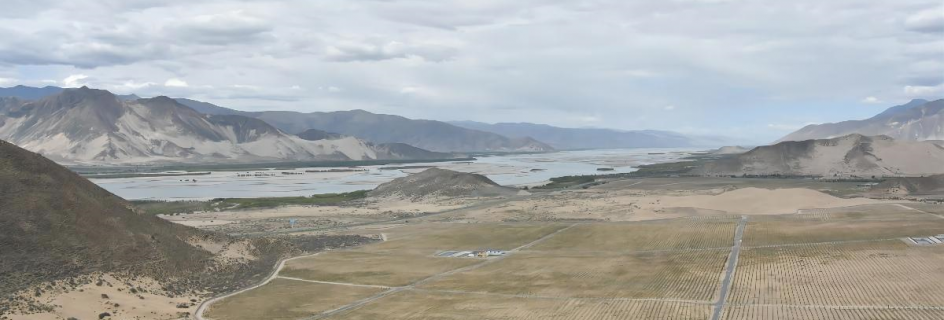Post date:
An international research team including the School’s Emeritus Professor, Alistair Borthwick, has developed a new model to improve predictions of future rainfall and climate change in Asia.
In a paper recently published in Nature Communications, the team demonstrated a method of data analysis to improve predictions about how global warming will affect future rainfall in the continent – which is home to around half the world’s population.
Current climate modelling
Environmental scientists and engineers currently base climate change and weather predictions on Global Climate Models (GCMs), which simulate the physical behaviour of atmospheric and ocean systems, now and into the future.
Such estimates are vitally important in helping governments and societies to predict and lessen the impacts of climate change, including the effect on critical water resources.
These forecasts generally agree that the climate in Asia is likely to become wetter in coming years. However, different GCMs forecast significantly different levels of rainfall, due to the complex interplay of factors such as sea-air interactions, tropical monsoons, solar radiation, and variability in carbon emissions.
The team of researchers from the universities of Amsterdam, Wuhan, Edinburgh, Nanjing, Oxford, and Plymouth, used a newly developed technique from data analytics called “emergent constraints” to reduce uncertainty in climate forecasts for Asia.
Illuminating new trends
Emergent constraints are discovered by identifying trends in data which relate model simulations of the present climate to projections of the future climate. For such trends to be useful in practice, the researchers also look for evidence of physical factors that help back up their predictions and can be verified independently of their models.
The researchers applied the “emergent constraint” technique to analyse relationships between temperature growth rate from 1970 to 2014, and rainfall growth rate from 2015 to 2100 across Asia.
They examined 27 different GCMs from the World Climate Research Programme’s Coupled Model Intercomparison Project Phase 6 (CMIP6), which predict levels of greenhouse gas emissions ranging from low and intermediate to high, and very high.
The researchers discovered so-called “constraint relationships” between growth rates of temperature and rainfall in Asia, based on a plausible physical cause – the release of latent heat by water vapour, which then warms the atmospheric environment.
The results show that the CMIP6 models accurately capture the effect that rainfall has on the atmosphere, whereby increased water vapour in wetter conditions causes a stronger warming effect on temperature.
Key findings
By applying this emergent constraint relationship between simulated historical temperature growth rate and future precipitation growth rate to temperature observations, the team were able to reduce uncertainty in future rainfall projections by up to 31%.
Key findings of the study:
- Existing CMIP6 models overestimate the future temperature growth rate in Asia by between 3.4% and 11.6%
- The same models overestimate the total evaporation growth rate by between -2.1% and 13%, and hence the projected increase in future water availability across Asia.
- The slower warming implies that loss of snow cover in Asia, notably in the Himalayas, will be 10.5% to 40.2% slower than previously predicted.
Climate change in Asia
As the Earth warms, Asia will experience increased heat stress, with potential consequences including:
- longer fire seasons and increased frequency and intensity of wildfires.
- increased health problems caused by heat exposure, particularly in India.
- further desertification, soil erosion, dune mobilisation, sandstorms, and air pollution in China, particularly in its arid and semi-arid north-western regions.
- lower crop production in some regions.
- reduced water levels in some rivers and lakes, causing potential damage to fish populations, increased contamination, and accelerated algal growth (eutrophication).
- glacier retreat and increased snowmelt in areas such as the Himalayas and Nepal, leading to an increased risk of extreme floods, avalanches and landslides which would inundate downstream cities, urban areas, and farmland.
By improving the accuracy of climate forecasts across Asia, the research will equip authorities to better prepare for such extreme weather events, through measures such as revegetation, the creation of ‘shelterbelts’ of trees and shrubs to protect land from extreme weather, and flood alleviation and warning systems.
“Better forecasts”
Professor Alistair Borthwick explained, “Understanding of the relationships between global warming and future rainfall parameters is key to estimating the scale, intensity, and future occurrences of flood and drought events worldwide.
“Using the latest techniques in data analytics, our work has determined empirical relationships called emergent constraints that should enable water experts to provide better forecasts of future precipitation in Asia.”
Team
The researchers working on the paper were:
- Yuanfang Chai of Wuhan University and Vrije Universiteit Amsterdam
- Yao Yue and Jiabo Yin of Wuhan University
- Louise Slater of Oxford University
- Alistair Borthwick of the University of Plymouth and the University of Edinburgh
- Tiexi Chen and Guojie Wang of Nanjing University of Information Science and Technology
The study was directed by Yuanfang Chai and Yao Yue.



